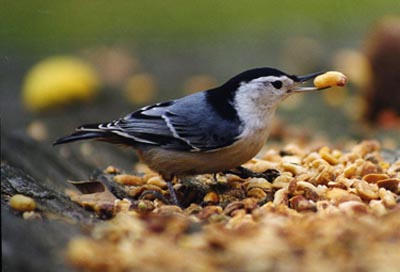 Right now chickadees, nuthatches and titmice are hiding food to retrieve and eat at a later time. This behavior is called “caching.” Caching helps birds survive during bad weather and when food sources are low.
Right now chickadees, nuthatches and titmice are hiding food to retrieve and eat at a later time. This behavior is called “caching.” Caching helps birds survive during bad weather and when food sources are low.
These birds store hundreds of seeds a day, and each seed is placed in a different location and they generally remember where each one is even a month later.
By providing an easily accessible food source, you can help your birds with their caching needs. Below is a little more detail on some of your favorite birds’ caching behaviors.
Chickadees
• Cache seeds (in the shell and out), nuts, insects and other invertebrate prey
• Food is typically cached about 100 feet from feeders
• Cache more during the middle of the day
• May carry off several seeds at a time, but each item is stored in a separate location
• Store food in knotholes, bark, under shingles, in the ground and on the underside of small branches
Nuthatches
• Prefer to cache hulled sunflower seeds, because they are easier and faster to cache; occasionally mealworms
• Choose heavier seeds (because they are larger or have a higher oil content)
• Food is typically cached about 45 feet from feeders
• Most active caching time is early in the day
• Store food in bark crevices on large tree trunks and on the underside of branches
Titmice
• Cache sunflower, peanuts and safflower
• Food is typically cached about 130 feet from feeders
• Cache one seed at a time and typically choose the largest seeds available
• Often remove seeds from their shell (80% of the time) before hiding them
What caching activity have you seen in your yard?